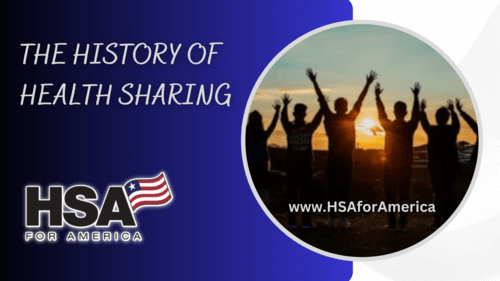
The History of Health Sharing
The modern health sharing ministry organization evolved in the 1980s as a way of helping families deal with the rapidly rising costs of healthcare and health insurance—which itself was in part a byproduct of the inflation of the late 1970s and early 1980s.
But while many health sharing organizations are relatively new, the concept of community-based mutual aid associations is much older and dates back centuries. Watch this quick video to understand Health Sharing.
This article discusses the history of health sharing, from its roots in the Middle Ages to the technologically sophisticated modern health sharing ministry organizations of today.
Health Sharing’s Medieval Roots
Modern health sharing traces its conceptual roots back at least as far as the Middle Ages.
In the absence of anything like modern insurance, groups of craftsmen and tradesmen would band together on their own to form “guilds.”
These associations worked to protect the interests of craftsmen and tradesmen, control entry to the trades, create apprenticeship programs, set standards of craftsmanship and quality for their respective industries, and prevent exploitation of members by their employers.
Some of the most famous medieval guilds include those created by and for weavers, blacksmiths, and carpenters.
These medieval guild associations also focused inward and allowed members to pool funds to create their own social safety net for members and their families who fell on hard times.
Long before modern disability insurance, health insurance, or hospitals came into existence, tradesmen’s guilds banded together to provide economic assistance to members who were injured (a common occurrence), fell ill, or who died leaving family members behind.
These guilds continued to exist in Europe until the 19th century, and the Industrial Revolution in Europe, when they were gradually supplanted by trade unions and fraternal benefits associations (FBAs).
Compare Pricing on the Best HealthShare Plans Available
Fraternal Benefits Associations
Around the same time the Industrial Revolution was transforming European society, waves of immigrants made their way across the Atlantic to seek a new life in America.
Each new wave of immigrants faced difficulties in assimilating to their new home. New immigrants and their children faced language barriers, poverty, suspicion, and discrimination.
These immigrants frequently formed mutual aid associations of their own to help provide a social safety net for their members. Like the members of the earlier Medieval guilds, these immigrant groups would pool their resources to provide assistance to other members and to the sick, injured, widows, and orphans of their communities.
The earliest fraternal benefits associations were formed in the United States in the 18th and 19th centuries.
Many of these early American mutual benefits associations still exist today, including the Mason’s the Odd Fellows, the Ancient Order of Hibernians, and the Knights of Columbus.
Today, there are over 20,000 fraternal benefits associations in the United States. These associations offer a variety of benefits to their members, including insurance, financial assistance, educational programs and scholarships, and social activities.
Friendly Societies
Friendly societies are closely-related to fraternal benefits associations, and often overlap with them.
Friendly societies are often organized around a common interest, such as religion, ethnicity, or occupation. There are many different types of friendly societies, and they vary in size and scope. Some friendly societies are local, while others operate nationally or even internationally.
These societies have a long history, dating back to the 18th century in England. They were originally formed to provide mutual aid to their members in times of need.
Examples of friendly societies that still exist today include: The Woodmen of the World, Veterans of Foreign Wars, the Loyal Order of Moose, the Daughters of the American Revolution, the National Association of Colored People, and the National Council of Jewish Women.
These societies are all non-profit organizations that provide a variety of services to their members, such as social activities, educational programs, and financial assistance. They are also a source of community support and fellowship for their members.
Learn More: The Media’s Misguided Portrayal of Health Sharing Organizations
The Progressive Era
Mutual aid organizations were a key part of the social fabric during the Progressive Era in the United States, which ran from roughly 1896 to 1917.
They provided a wide range of services to their members, including financial assistance, healthcare, and childcare.
Some of the most well-known mutual aid organizations from the Progressive Era include the Knights of Labor, the Farmers’ Alliance, and the National Association for the Advancement of Colored People (NAACP).
These organizations played a significant role in improving the lives of millions of Americans. They also helped to raise awareness of social issues, advocate for change, and provide much-needed services to their communities.
Amish and Mennonite mutual aid groups were also very active during the Progressive Era. They had ministries specifically focused on helping members during times of illness or while recovering from injuries.
These Progressive Era mutual aid societies are the most direct predecessors of today’s modern health sharing organizations.
The Rise of Modern Insurance
At their peak in the 20s and 30s, as many as a third of Americans were members of mutual aid associations.
However, these old ethnic, religious, and community-based associations have been gradually supplanted by the rise of modern insurance companies, mass media and advertising, and greater assimilation into America’s melting pot.
Older associations such as the Mennonite and Amish mutual aid societies shrank due to lower birthrates and outmigration from those communities.
The postwar boom also transformed society, moving millions of veterans and family members out of urban areas to the suburbs in a building boom fueled by the GI Bill, further eroding the communities that gave rise to earlier fraternal benefit organizations.
The Rise of the Modern Health Sharing Ministry Organization
In the 1980s, the rising costs of healthcare and health insurance led many people to seek out alternative options. Some people began forming health sharing ministries, which are non-profit organizations that pool funds from their members to pay for medical expenses.
These organizations were and are more affordable than traditional health insurance plans, and they provided a sense of community among their members. The modern health sharing ministry organization is a direct result of the high insurance premium increases in the 1980s.
Today, many faith-based health sharing communities are following in the footsteps of the Amish and Mennonite societies, the Woodmen of America, and other mutual aid associations of the Progressive Era.
The Mennonite mutual aid society lives on today in the form of Anabaptist Healthshare.
Examples of faith-based health sharing ministry organizations include Medi-Share and OneShare Health.
United Refuah Health Share serves the Jewish community across the United States, while Universal Healthshare, open to all applicants, was created by members of the Unitarian Universal church.
Today, health insurance premiums continue to rise. And while the effects of rising health insurance prices are masked for many people thanks to the Affordable Care Act subsidies for Marketplace insurance plans, health sharing plans are extraordinarily popular among those who don’t qualify for a subsidy, or who value the ability to choose their own doctor.
For those who don’t get an ACA subsidy, and who are in relatively good health, health sharing plans routinely save members about 40 to 50% compared to a traditional health insurance policy.
Compare Pricing on the Best Insurance Plans Available
Join the Health Sharing Movement
Today, nearly 2 million Americans have dropped overpriced, over-regulated and restrictive traditional health insurance products in favor of more affordable health sharing organizations.
You can choose a faith-based health sharing ministry, a non-denominational Christian organization, or a health sharing plan with a completely secular approach.
HSA For America is America’s leading broker of health sharing plans, and provides expertise on both healthsharing and traditional health insurance solutions for individuals, families, employers, and associations.
To learn more, or to get help finding and enrolling in a health sharing plan that’s right for you, click here for a free consultation and quote from one of our experienced Personal Benefits Managers.
For Further Reading: How Much Can Health Sharing Save Compared to Health Insurance? | The Pros and Cons of Religious Vs Secular Health Sharing Plans | Best Healthshare Plans Comparison Guide 2024

